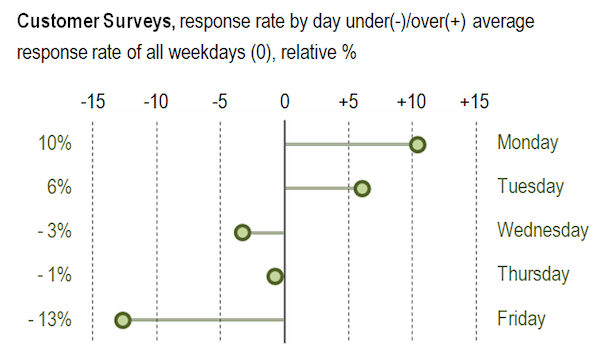When it comes to getting customer feedback, you may casually ask patrons questions in your store and look at your online reviews from time to time. But if you want to truly gauge how your business is performing and what your customers expect, you can take extra steps to generate more consumer insight. Customer surveys are a great tool to get a large volume of data, and their anonymity encourages honest responses. So what makes a strong email survey? Here are some answers to questions you might have before getting started.
How do I write good questions?
For starters, your questions should be brief. Avoid wordiness, jargon or anything that could confuse the reader. Only ask one single question at a time. For example, rather than asking “How do you feel about our Facebook and Instagram pages?” you might split that into two questions so that both get answered individually. If you’re choosing an open-ended survey format where respondents type out their responses, do not ask yes/no questions. If all you get is a yes or no without the why, you won’t be learning much about what you do well or what you can improve on. Be precise in your language and avoid subjective words like “generally” or “often,” which could mean different things to different people.
If you want honest answers, avoid leading questions. For example, you could say, “We recently renovated our showroom to make the customer experience better than ever. How do you like the new space?” Instead, ask, “What are your thoughts on our renovated showroom?” You may be biased toward your business, but you need to stay objective to get the most useful answers.
How long should a survey be?
To get answers to all your questions for customers, you may be tempted to send out a 30 question survey. But too many questions will usually mean far fewer responses. To make surveys easier for respondents to tackle, you might consider sending out a few bite sized surveys a year rather than one or two big ones loaded with too many questions. Or if you’d prefer to create a longer survey to get more data at once, consider offering an incentive like a discount to those who fill it out for higher response rates.
While the exact number of questions you include is really up to you, there are some general guidelines to follow. A study from SurveyMonkey found that survey abandonment rates increased for surveys that took more than 7-8 minutes to complete. The study also found that tolerance for longer surveys was lower for customer-related surveys than for work or school-related surveys. Use as few questions as possible to get the answers you need. Regardless of the length, make sure to test out how long it will take and put that time estimate at the top of your survey so recipients know what they’re getting into.
When should I send it?
SurveyMonkey studied response rates across 100,000 surveys to find out what the best times are to send them. Response rates were highest for those sent on Monday and lowest for those sent on Friday.

This is just one study, and there’s a whole host of research out there on the best times to send marketing emails. You know your customers best, so use your best judgment on when to send your survey. Try doing some A/B testing on your other marketing emails to see when open rates are strongest and send your survey out then.
What other questions do you have about how to survey your customers? Let us know in the comments!
Photo: Pexels user Lukas







